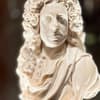Podcast
Questions and Answers
What is the deep fascia of the thigh called?
What is the deep fascia of the thigh called?
Fascia lata
What are the three compartments of the thigh?
What are the three compartments of the thigh?
- Anterior, medial, posterior (correct)
- Anterior, lateral, inferior
- Superior, medial, inferior
- Lateral, medial, posterior
The superficial fascia of the anterior abdominal wall extends downward to the front of the thigh, forming two layers: a superficial fatty layer and a deep membranous layer.
The superficial fascia of the anterior abdominal wall extends downward to the front of the thigh, forming two layers: a superficial fatty layer and a deep membranous layer.
True (A)
What muscle is responsible for flexing the thigh?
What muscle is responsible for flexing the thigh?
Match the following muscles with their primary actions:
Match the following muscles with their primary actions:
The ______ compartment of the thigh contains the adductor muscles and obturator nerve.
The ______ compartment of the thigh contains the adductor muscles and obturator nerve.
What nerve supplies the quadriceps femoris muscle?
What nerve supplies the quadriceps femoris muscle?
The iliopsoas muscle is a single muscle.
The iliopsoas muscle is a single muscle.
What is the function of the intermuscular septa?
What is the function of the intermuscular septa?
What is the main function of the articularis genus muscle?
What is the main function of the articularis genus muscle?
Which of the following structures is NOT found within the deep fascia of the thigh?
Which of the following structures is NOT found within the deep fascia of the thigh?
The rectus femoris muscle is the only muscle in the quadriceps femoris group that does not directly attach to the femur.
The rectus femoris muscle is the only muscle in the quadriceps femoris group that does not directly attach to the femur.
What is the primary artery that supplies blood to the anterior compartment of the thigh?
What is the primary artery that supplies blood to the anterior compartment of the thigh?
Which muscle assists in external rotation of the thigh?
Which muscle assists in external rotation of the thigh?
Flashcards
Superficial Fascia of Thigh
Superficial Fascia of Thigh
A layer of tissue below the skin of the thigh, composed of fatty and membranous layers, containing blood vessels and lymph nodes.
Deep Fascia (Fascia Lata)
Deep Fascia (Fascia Lata)
A tough fibrous sheet that wraps around the entire thigh, thickening into the iliotibial tract.
Iliotibial Tract
Iliotibial Tract
A thickened part of the deep fascia on the lateral side of the thigh, extending from the ilium to the tibia.
Intermuscular Septa
Intermuscular Septa
Signup and view all the flashcards
Anterior Thigh Compartment
Anterior Thigh Compartment
Signup and view all the flashcards
Medial Thigh Compartment
Medial Thigh Compartment
Signup and view all the flashcards
Posterior Thigh Compartment
Posterior Thigh Compartment
Signup and view all the flashcards
Sartorius Muscle
Sartorius Muscle
Signup and view all the flashcards
Quadriceps Femoris
Quadriceps Femoris
Signup and view all the flashcards
Rectus Femoris
Rectus Femoris
Signup and view all the flashcards
Study Notes
The Thigh
- The thigh comprises skin, superficial fascia, deep fascia, and muscles.
Superficial Fascia
- The superficial fascia of the anterior abdominal wall extends down to the thigh.
- It's composed of 2 layers: superficial fatty layer and deep membranous layer.
- The fatty layer continues down the lower limb without interruption.
- The membranous layer attaches to the deep fascia (fascia lata) below the inguinal ligament.
- The superficial fascia contains superficial inguinal vessels, lymph nodes, and the great saphenous vein.
Deep Fascia of the Thigh (Fascia Lata)
- Fascia lata is a tough fibrous sheet enveloping the thigh.
- Superiorly, it's attached to the inguinal ligament, iliac crest, sacrum, coccyx, sacrotuberous ligament, and pubis, pubic arch, ischial tuberosity.
- Inferiorly, it's attached to the front and sides of the knee (femur, tibia, patella, and fibula).
- It thickens laterally to form the iliotibial tract, extending from the tubercle of the iliac crest to the lateral condyle of the tibia.
- Includes intermuscular septa dividing the thigh into 3 compartments.
Intermuscular Septa
- Three intermuscular septa divide the thigh into 3 compartments: anterior, medial, and posterior.
- The lateral septum extends from the lateral lip of the linea aspera to the iliotibial tract.
- The medial septum extends from the medial lip of the linea aspera to the deep fascia on the medial side
- The posterior septum extends from the medial lip of the linea aspera to the deep fascia on the posterior side, being poorly defined.
Compartments of the Thigh
- Anterior compartment:
- Muscles: sartorius, iliacus, psoas major, quadriceps femoris.
- Blood supply: Femoral artery.
- Nerve supply: Femoral nerve.
- Medial compartment:
- Muscles: gracilis, pectineus, adductor longus, adductor brevis, adductor magnus, obturator externus.
- Blood supply: Obturator and profunda femoris arteries.
- Nerve supply: Obturator nerve.
- Posterior compartment:
- Muscles: biceps femoris, semitendinosus, semimembranosus (hamstrings).
- Blood supply: branches from profunda femoris artery.
- Nerve supply: sciatic nerve.
Muscles of the Thigh
- Various muscles are detailed (Sartorius, Iliacus, Psoas, Pectineus, Rectus Femoris etc). Each muscle has its origin, insertion, nerve supply, actions etc.
Quadriceps Femoris Muscle
- The quadriceps femoris is a large muscle with four parts: rectus femoris, vastus lateralis, vastus medialis, and vastus intermedius.
- Its origin and function are described.
Lateral and Medial Patellar Ligaments
- These ligaments extend from vastus lateralis and medialis into the knee joint capsule.
- Nerve supply: Femoral nerve.
Articularis Genu Muscle
- A small muscle that originates from the femur and inserts into the synovial membrane associated with the knee joint.
- Its action involves pulling the synovial membrane during extension.
Studying That Suits You
Use AI to generate personalized quizzes and flashcards to suit your learning preferences.





